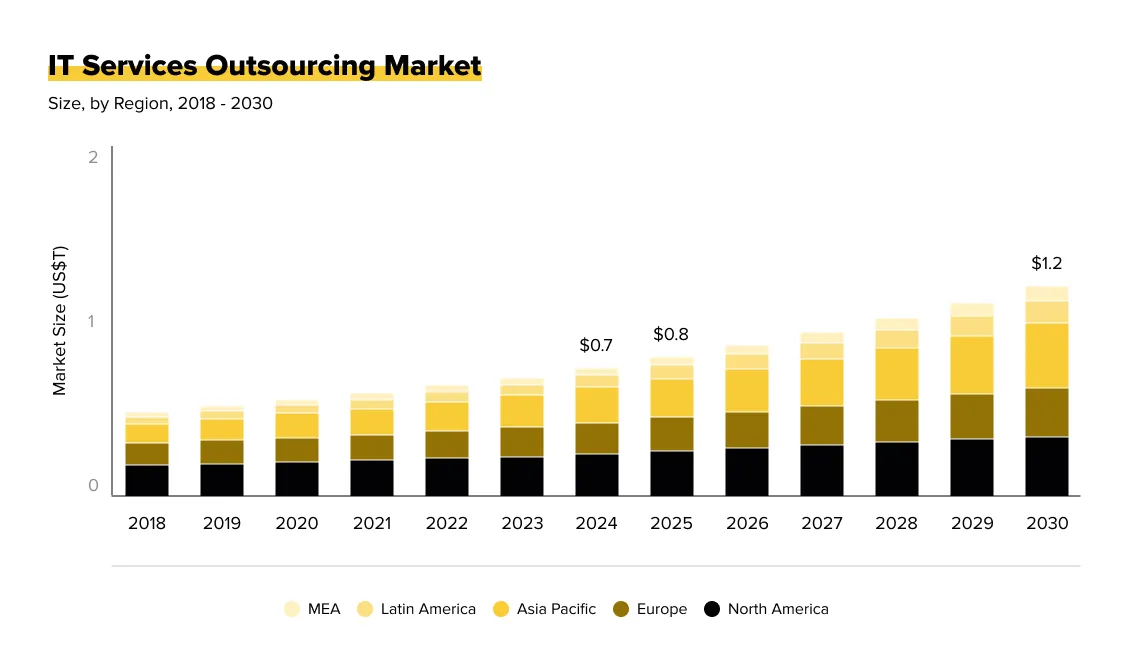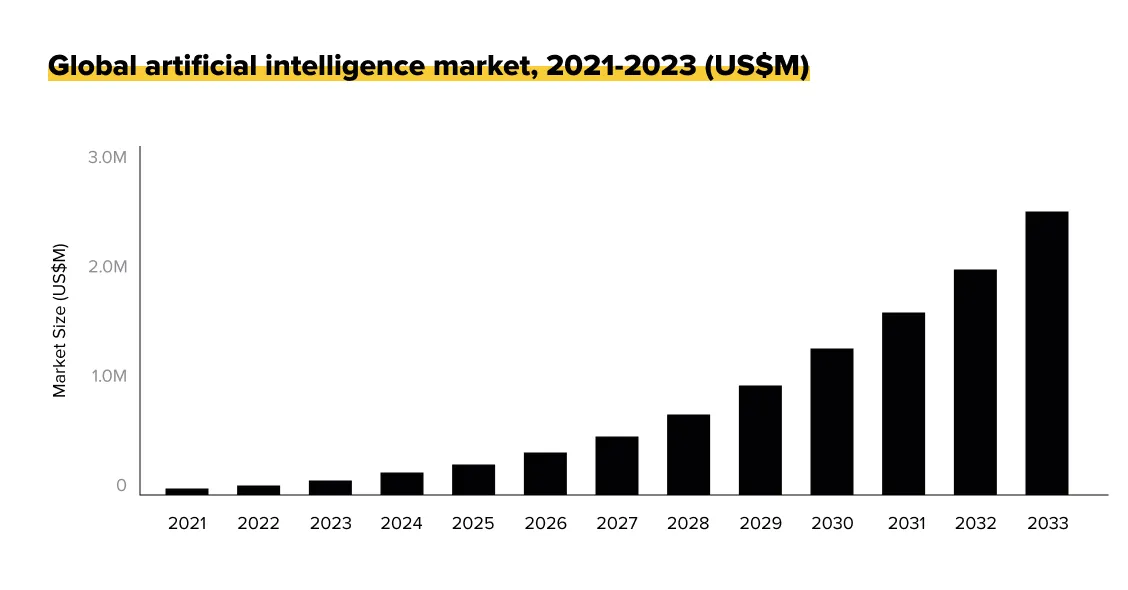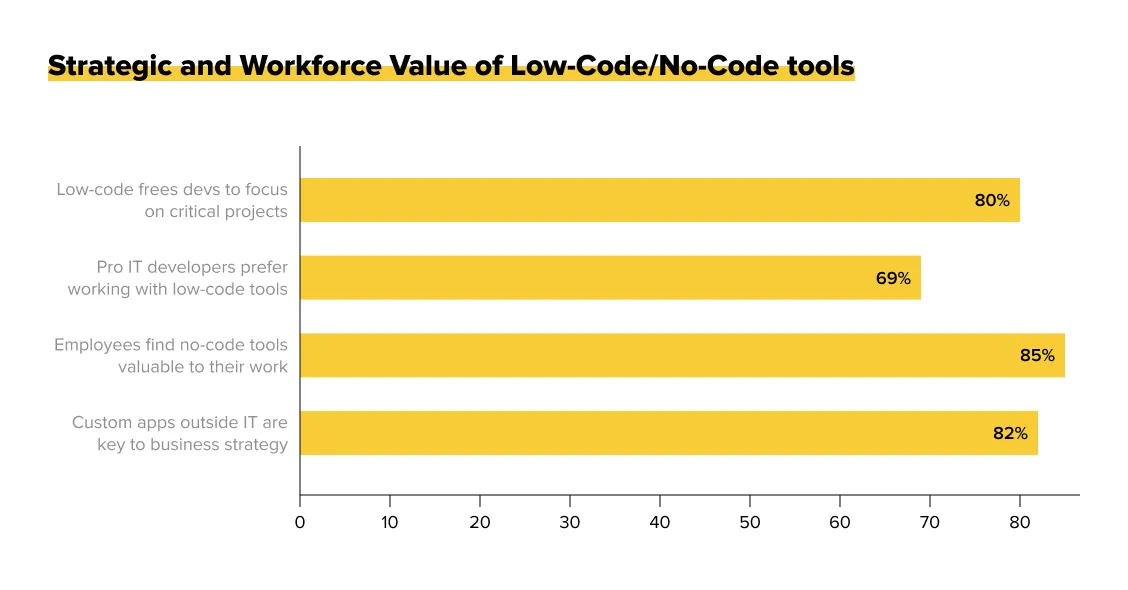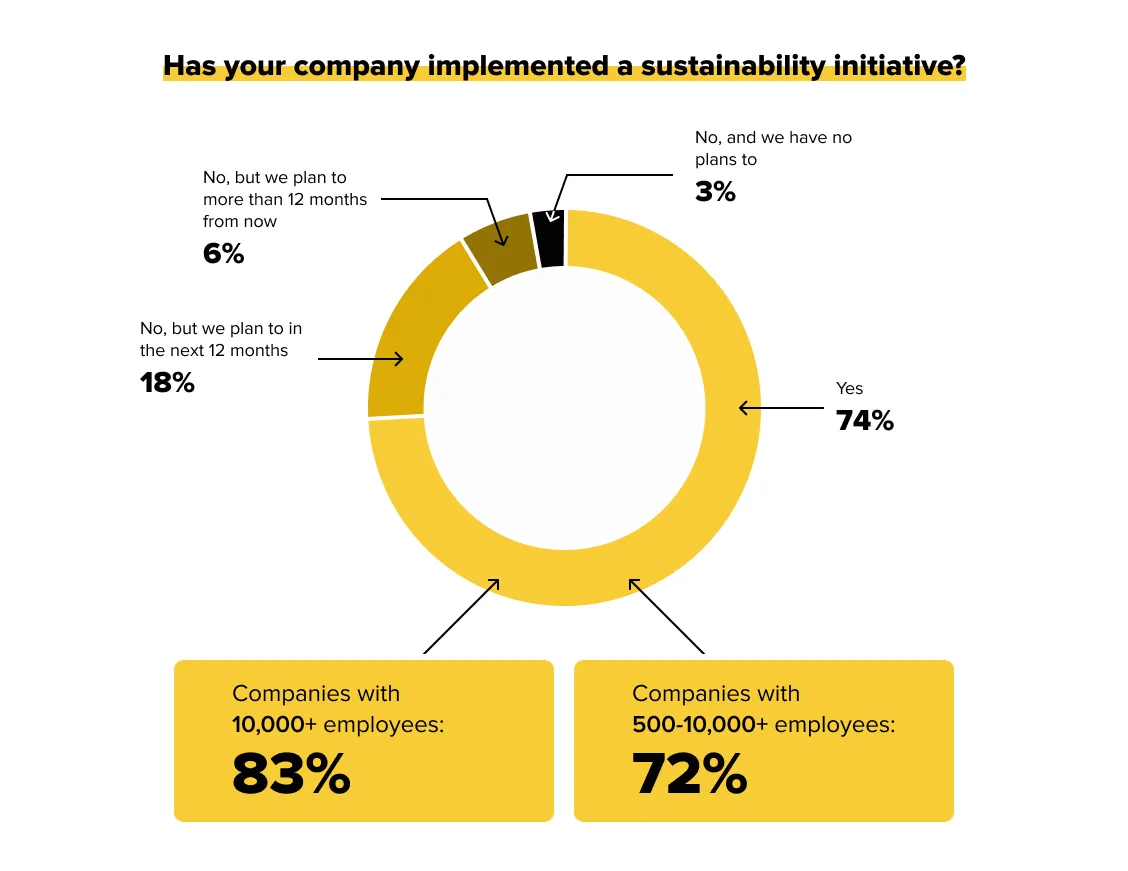Looking for the most comprehensive guide on software development outsourcing trends 2025-2026?
Then stay with us. We will provide you with the top 10 software outsourcing trends for 2025, software development outsourcing statistics for 2025-2026, and a concise market snapshot. This guide will help heads of engineering, founders, CIOs, and CTOs with partner selection, budgeting, and delivery models. In this guide, you will find out emerging trends in the software development industry, including GenAI adoption, cloud modernization, security & compliance pressures, and talent scarcity. Here we go!
What the Market Forecast Says for 2025
In 2025, steady growth, stronger demand for cloud-native skills, data/AI, and security is forecasted.
When it comes to the most essential reasons why different outsourcing software development services have become increasingly popular in 2025, cost saving is not the only goal of outsourcing strategies:
Software Development Outsourcing Trends 2025–2026: A Comprehensive Guide
Businesses now prioritize value-driven outsourcing.
The project-based model offers flexibility to access needed skills.
Multiple global delivery models enhance efficiency and speed.
We can emphasize growth drivers, including GenAI productivity enhancements, faster time-to-market, cost discipline/FinOps, as well as compliance/data residency. Let’s consider them in detail:
Generative AI Productivity Lift. AI-driven tools are transforming software development by automating coding tasks, reducing the need for extensive human input, and accelerating project timelines.
Faster Time-to-Market. Outsourcing enables companies to expedite product development cycles, achieving up to 50% faster time-to-market, which is crucial in competitive industries.
Cost Discipline and FinOps. Organizations are increasingly adopting financial operations (FinOps) practices to optimize spending on outsourced services, balancing cost savings with value delivery.
Compliance and Data Residency. With stringent data protection regulations, businesses are prioritizing outsourcing partners that ensure compliance and meet data residency requirements.
Software Development Outsourcing Statistics
In 2025, strong market growth is forecasted: 57% of recruitment managers think that finding skilled IT employees is a difficult task. The demand for technology outsourcing trends leads to a bigger market size. The IT service outsourcing market value was $744,623.5 million in 2024, with a CAGR of 8.6% from 2025 to 2030. Stronger demand for cloud-native skills, data/AI, and security is predicted in the market.

The IT outsourcing industry is becoming more and more popular among companies, since about 92% of Global 2000 (G2000) companies use outsourced IT services. Additionally, outsourcing services can cut companies’ costs by 15 to 30%. The cost advantages help decrease IT budgets and provide access to expert skills without full-time hire.
Outsource development services rise because of the talent shortage in this field. When it comes to the regions with the largest number of seniors in the outsourcing development field, we can mention Vietnam and the Philippines in Southeast Asia; Mexico, and Latin America, providing US companies with outsourcing talents.
Among the most outsourced functions, we can emphasize web/mobile, cloud/platform, data/AI, QA & test automation because almost every business needs customer-facing websites, apps, and portals. Outsourcing provides quick access to large pools of developers. Development companies can’t always keep in-house expertise for all frameworks, so they hire specialized professionals for outsourcing partnerships. Workloads for new apps or feature expansions are typically project-based, making them ideal for outsourcing projects. Firms spin up external teams instead of hiring full-time.
Top 10 Software Outsourcing Trends Shaping 2025
We will provide you with the 10 latest software outsourcing trends shaping 2025 according to several criteria, including frequency in RFPs, measurable ROI, and maturity of adoption. You will find out what each trend has become popular and why it’s so essential in the outsourcing field. AI, big data, and cybersecurity are thriving key IT outsourcing trends. Outsourcing companies need to reskill and adapt fast. Here we go!
Trend 1: GenAI in Delivery (Copilots, Code Review, Productivity)
Today, AI is widely used in diverse fields of our lives since the AI software development industry is increasingly developed. By 2030, global revenue may hit $1.81 trillion. Businesses apply AI outsourcing to take leading positions in their fields.

AI and ML, including generative AI, automate software development tasks or reduce development time. AI-enabled workers and AI testing frameworks help with coding tasks. In programming, AI-powered automation is used for faster and more reliable results.
AI and ML improve user experience with personalization. With AI-based code review, you get smarter recommendations and better decision-making. In the AI field, it’s very difficult to find experts. Therefore, companies are looking for outsourcing professionals to delegate work tasks. It enhances cycle time, PR throughput, and decreases defect rate.
To start working with outsourcing AI software developers, follow these easy tips:
Hire outsourcing professionals who have proven AI and ML expertise;
Check if they have delivered any similar software development projects. They should have certified experts and a well-built development process.
Pay attention to data quality, security, and privacy.
Find out how IT outsourcing helps small businesses.
Trend 2: Data-Driven Engineering (DORA/SPACE, Value Tracking)
Modern engineering teams link the full chain — repo → pipeline → production → business metrics — to see how code changes translate into customer and company outcomes. Instead of measuring lines of code, teams use dashboards and rituals (like a weekly ops review) to ground conversations in outcomes over output. This means engineering leaders can correlate deployment health with customer value delivered, ensuring investments align with impact. By adopting frameworks, including DORA and SPACE, data-driven engineering teams provide companies with continuous improvement and transparency.
Among the most popular KPIs, we can emphasize Lead Time for Changes, Mean Time to Recovery (MTTR), and Release Frequency.
Metric Type | Output-Focused | Outcome-Focused |
Stability | Bug count | MTTR |
Delivery | A number of tickets closed | Release frequency |
Productivity | A number of commits | Lead time for changes |
Trend 3: Cloud-Native & Multi-Cloud (Platform Engineering)
Engineering teams are embracing internal developer platforms that offer golden paths and self-service templates for deploying services, databases, and infrastructure. These platforms accelerate delivery by reducing cognitive load while embedding security and compliance guardrails by default.
Among the most essential benefits of cloud-native and multi-cloud implementation, we can emphasize faster time-to-market, consistent standards, and FinOps practices to rein in cloud spend. On the other hand, the rise of multi-cloud strategies introduces risks of tool sprawl and vendor lock-in. Forward-looking teams mitigate this with standardized APIs, cross-cloud orchestration, and open-source tooling to preserve flexibility. As a result, companies can get a balance of speed, compliance, and cost control without sacrificing long-term resilience.
Trend 4: Security by Design (DevSecOps, SBOM, Zero-Trust)
Security threats increase day by day. Companies face a huge number of development challenges, including breaches and attacks from hackers. In the US, 76% of states outsourced security operations in 2024. This figure in 2022 was just 52%.
A lot of businesses prefer security-focused outsourcing services for better data security and compliance management. For these purposes, outsourcing services implement cutting-edge modern solutions, including shift-left security, dependency inventory (SBOM), and signed artifacts. With a shift-left approach, teams embed security into design, coding, and CI/CD pipelines so vulnerabilities are caught when they’re cheaper and easier to fix. Development teams maintain a software bill of materials (SBOM) and require signed artifacts to track dependencies and prove integrity. Practical checks include secret management (no credentials in code), infrastructure-as-code (IaC) scanning for misconfigurations, and SAST/DAST to identify vulnerabilities at the earliest stages.
Trend 5: Low-Code/No-Code + Pro-Code Fusion
Low-code and no-code development belong to one of the most popular trends in custom software development outsourcing. In the US, 41% of companies use low-code tools for app development. By using this approach, you design apps with minimal coding. This approach speeds up development and reduces costs.

With minimal coding, your business relies less on developers. You will free up IT resources. This approach also allows you to add customer codes and plugins. As a result, you will get an app that will perform better across diverse platforms.
In-house teams can design low-code apps, but an outsourcing approach is the best option for this, when teams of high-end professionals can customize faster time-to-value without sacrificing quality and security.
When applying for an outsourcing service, choose an experienced company to take full advantage of low-code and no-code development. And don’t forget about security and compliance — while low-code and no-code development solutions are flexible and fast, they may risk security.
Trend 6: Intelligent Automation Beyond RPA (Orchestration, AI Agents)
RPA is becoming increasingly popular in outsourcing software development. In 2024, its market reached USD 3.79 billion. It’s predicted that this market will grow to USD 30.85 billion by 2030, with an annual growth rate of 43.9% from 2025.
RPA was created to help businesses handle repetitive tasks. It uses software bots to automate processes. To work on RPA, you don’t have to create an in-house team. You can search for outsourcing RPA experts to design and deploy automation efficiently. Finally, you can reduce training costs and speed up progress, while an outsourcing team will provide you with ongoing support.
Trend 7: Outcome-Based Partnerships (Shared OKRs, Product Focus)
Business process outsourcing models are shifting from time-and-materials (T&M) to result-centric contracts that emphasize business outcomes. Instead of billing for hours, software development partners are measured on shared OKRs such as feature adoption, improvements in unit economics, or reductions in MTTR. This alignment ensures vendors focus on delivering product value, not just output. Successful engagements often start with a pilot phase to validate fit, de-risk commitments, and build trust. Once proven, partnerships expand under frameworks that tie incentives directly to customer and business impact.
Trend 8: Nearshoring Momentum (LATAM, Eastern Europe; Follow-the-Sun)
Nearshoring is accelerating as companies seek time-zone alignment, cultural affinity, and strong English proficiency from partners in LATAM and Eastern Europe. These regions enable real-time collaboration with North America and Western Europe, reducing friction in agile delivery. Many companies mix nearshore and offshore outsourcing to achieve 24/5 coverage — nearshore for overlap and rapid iteration, offshore software development services for overnight progress. However, effective strategies also require geo-risk assessment (political, economic, and regulatory) and contingency planning to maintain continuity in volatile environments. The result is a balanced global model that optimizes speed, cost, and resilience.
Region | Advantages | Disadvantages |
LATAM | Time-zone overlap with US, cultural fit | Wage inflation, political shifts |
Eastern Europe | Strong STEM talent, English proficiency | Regional conflict, EU regulation |
Offshore (Asia) | Scale, cost efficiency | Less overlap, communication gaps |
Choosing between outsourcing and offshoring services? Find out what’s better: outsourcing vs offshoring.
Trend 9: AI-Powered QA & Shift-Left Testing
Since AI is widely used in different fields, AI-powered QA has also become more and more popular. AI testing frameworks assist with coding tasks. AI-driven test generation enables autonomous creation of unit, integration, and even contract tests directly from code and API specs. Businesses track metrics like coverage improvement, defect leakage, and time-to-fix to assess impact.
While AI can handle repetitive and high-volume scenarios, people remain in the loop for exploratory testing and critical business flows where context and judgment play the most significant role. As a result, teams can get faster, safer releases with QA embedded at early stages.
Trend 10: Sustainable & Green IT (ESG in Selection)
Sustainability takes tenth place among the latest outsourcing trends in 2025. According to OpenText, 97% of companies have adopted or plan to make sustainability efforts.

The most important purpose of eco-friendly IT outsourcing trends is to reduce energy consumption. To achieve a greener tech environment, energy-efficient infrastructure and cloud-first strategies are developed while physical data centers are eliminated.
For instance, Google now uses 100% renewable energy to operate its data centers, reducing power consumption and relevant energy costs.
To contribute to green IT development, you can choose green-focused providers. While delivering energy-efficient solutions, they help reduce the carbon footprint related to traveling. Additionally, you can optimize cloud resources to reduce energy consumption as well as monitor and minimize e-waste while working on IT systems.
Practical Considerations: Making Trends Work
When it comes to hiring employees, it’s very important to engage the most efficient model. If you need to scale capacity for well-defined tasks quickly, for instance, adding QA engineers during a release crunch, the best option will be staff augmentation.
Managed teams provide an autonomous squad with delivery responsibility, ideal for ongoing functions, including platform engineering or DevOps. Product delivery partners own an entire outcome end-to-end, such as building a new mobile app or migrating a legacy system to the cloud. Each model balances flexibility, accountability, and risk differently.
Success also depends on starting small. Begin with a discovery workshop to align on scope and constraints, move into a proof of concept (PoC) to validate feasibility, and run a pilot to demonstrate measurable value. Define clear success criteria and exit/scale rules upfront so both sides know when to expand or pivot.
Finally, support collaboration with tooling and culture: adopt async-first communication, maintain documentation standards, schedule overlap hours for critical discussions, and capture decisions in shared logs. These practices reduce friction and ensure distributed teams stay aligned.
Follow this easy-to-use guide:
Pick the right model (staff augmentation, managed teams, or product delivery).
Run a discovery workshop with the partner.
Launch a PoC with clear success metrics.
Establish async-first tools, docs, and overlap hours.
Define exit or scale-up criteria before committing long-term.
How to Choose a Software Development Outsourcing Company
While choosing outsourcing partners, state the goal to reduce risk and accelerate time-to-value. Then preview the evaluation framework, including capabilities, security, delivery model, culture, and proof. Let’s consider all the key factors while choosing an outsourcing team to collaborate with.

Capability & Domain Fit
Before hiring a software development outsourcing company, explore the team’s relevant experience. For this, ask for relevant case studies, domain certifications, and explore its portfolio depth (tech stacks, industries). Additionally, pay attention to this company’s ratio of seniors to mids, named leads (EM/Architect), and language proficiency. It’s very important to assess KPIs. For this, ask a team to show a similar problem they solved and the outcome.
Security, Compliance & Data Protection
When hiring a software development outsourcing team, ensure they meet baseline standards such as ISO 27001 or SOC 2, follow a secure SDLC, manage dependencies via SBOMs, and enforce strong secrets management and access control. Check for data residency and privacy compliance (GDPR/CCPA) with a signed DPA addendum, and require AI/model governance policies confirming client data is not used for training. Always request evidence — the latest audit letter, key policy excerpts, and an incident response plan summary — to validate trust and maturity.
Technical & Delivery Model Fit
When choosing a software development outsourcing team, initially, pay attention to stack alignment, including cloud (AWS/Azure/GCP), Kubernetes/IaC, CI/CD, and test practices (unit/contract/e2e). Then choose an engagement model: staff augmentation, managed team, or product delivery.
If you need an employee to complete well-defined tasks on a regular basis, think of staff augmentation. If you want a team that works autonomously with delivery responsibility, choose managed teams, ideal for ongoing functions. If you are searching for an entire outcome end-to-end, such as building a new mobile app or migrating a legacy system to the cloud, choose product delivery partners.
Start with a pilot and discovery workshop, then continue with a 2–4 week PoC, scale, and set exit/scale criteria upfront. Request clear metrics, including lead time, deployment frequency, MTTR, defect leakage, and CSAT/NPS to track impact.
Communication, Culture & Time Zone
After hiring a software development outsourcing team, establish overlap hours, async-first rituals (weekly demo, decision log, standups), and choose a working style. Additionally, select work tools for effective collaboration, including project tracking, documentation, and risk log cadence. Ask for a sample weekly plan detailing meetings, expected artifacts, and owners — this reveals how the partner structures communication and accountability across time zones.
Pricing, Contracting & SLAs
Successful outsourcing deals typically use time-and-materials (T&M) for flexible, evolving work; fixed-price for well-scoped projects; or outcome-based hybrids that tie spend to results. Strong SLAs/KPIs should cover response times, quality thresholds, and throughput, with clear change control and IP ownership clauses. Don’t overlook commercial hygiene: define termination rights, require a bench/backup plan for continuity, set a rate review cadence, and clarify holiday/coverage policies to avoid delivery gaps. Well-structured contracts protect both speed and stability.
References & Proof of Success
Before hiring a team, request 2–3 client references from a company similar in size and domain. When speaking with them, verify not just outcomes against the plan, but also communication quality, how issues were handled, and whether the vendor maintained team continuity. Ask for anonymized dashboards or redacted post-mortems to see delivery in practice — these artifacts reveal how a team tracks progress, manages risks, and learns from setbacks.
Why Choose Lampa as Your Software Development Outsourcing Partner
Lampa.dev offers a vast range of top-grade IT services, including mobile app development, smart TV, and TV box apps development, web development, software testing, UI/UX design, project management, and outstaff solutions. High-level expertise of the team in IT outsourcing and custom software development has earned recognition from top industry platforms. A wide range of awards highlights our commitment to delivering high-quality software development. Whether you are a startup or an SMB/enterprise, you will get cutting-edge AI-based solutions developed by Lampa.dev. We offer a fast full-stack workflow providing high-level reliability and security. Our process involves understanding your vision, boosting your product strategy, and delivering cost-effective software solutions.
Looking for the most reliable software development outsourcing partner to create a software project from scratch? Then order a free consultation right now. Our support manager will provide you with all the necessary information and guide you through all the workflow stages.
Explore some of our benefits:
60% senior-level professional across teams;
Delivered a fintech platform with cycle time reduced by 35% in under six months.
Trusted by Fortune 500 and high-growth scale-ups for mission-critical projects.
Final Thoughts: Turning Trends into Advantage
You have found out the top-10 software development outsourcing trends that are shaping the industry in 2025-2026. Businesses must stay agile and follow several trends for maximum benefits. Now, you are aware of all the most essential criteria while choosing and hiring a software development outsourcing team.
During the mass adoption of AI-based technologies, the time to revolutionize diverse industries has come. And you can’t stand aside to obtain leading positions. Hiring and cooperation formats also change in different fields, and the outsourcing format has become increasingly popular in the software development industry. With this work format, you can get a wide range of benefits, including automated coding services, 50% faster time-to-market, high cost efficiency, as well as compliance and data residency.
However, the first step to success is to choose the right partner. Then, focus on security, leverage Agile and DevOps to speed up delivery, and stick to breakthrough technologies to stay ahead. When put together, these factors can ensure a bright future of IT outsourcing right in your business.
Ready for the efficient collaboration that achieves faster time-to-value results? Choose Lampa.dev.